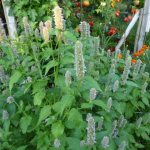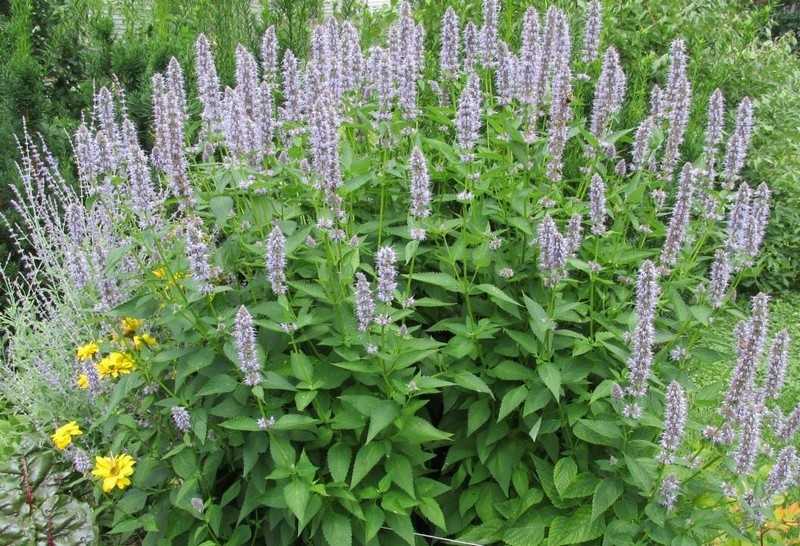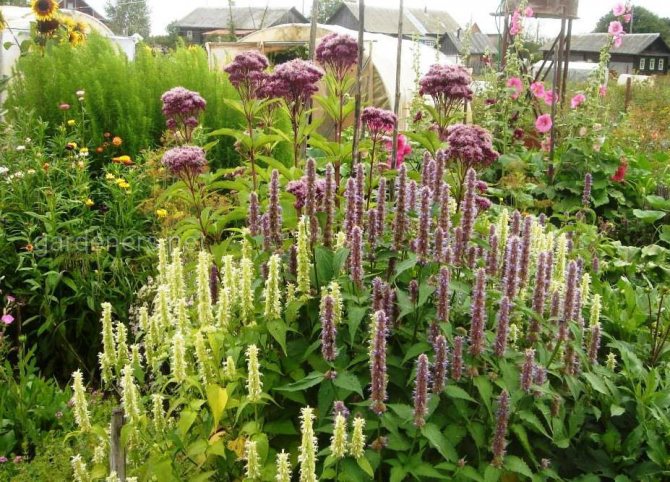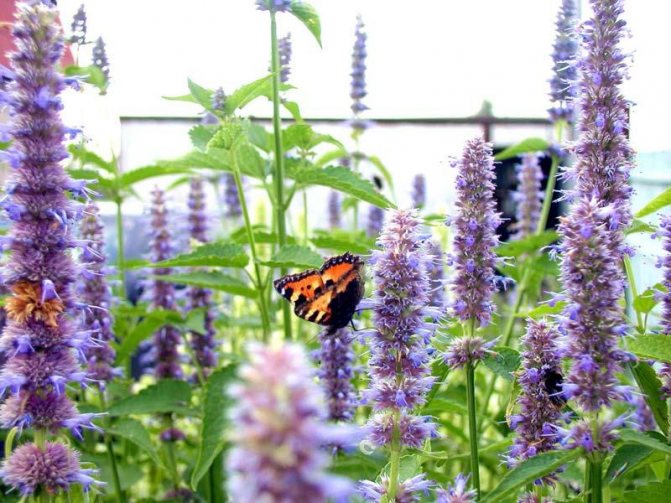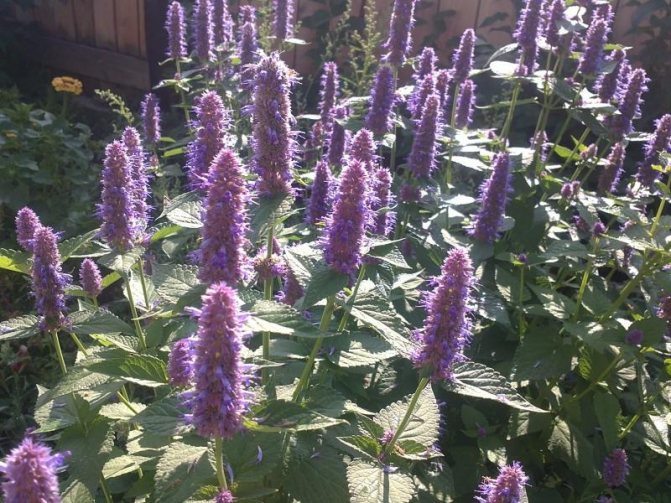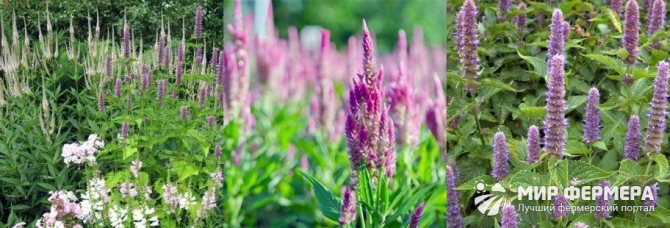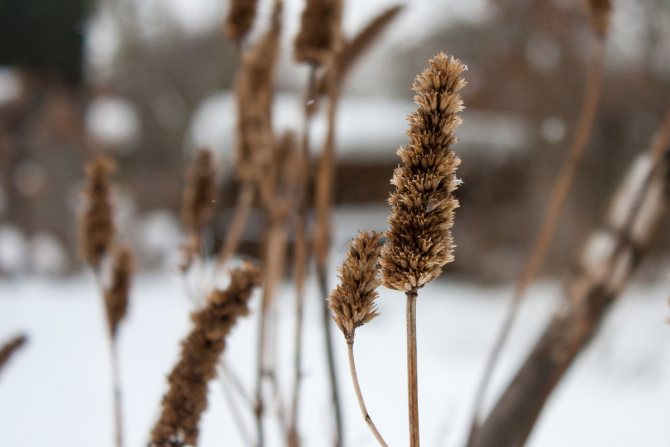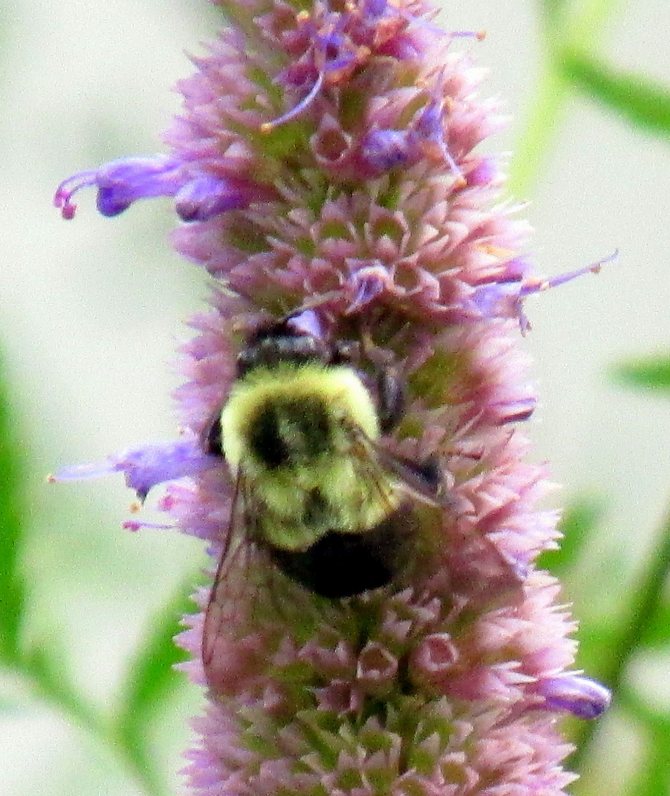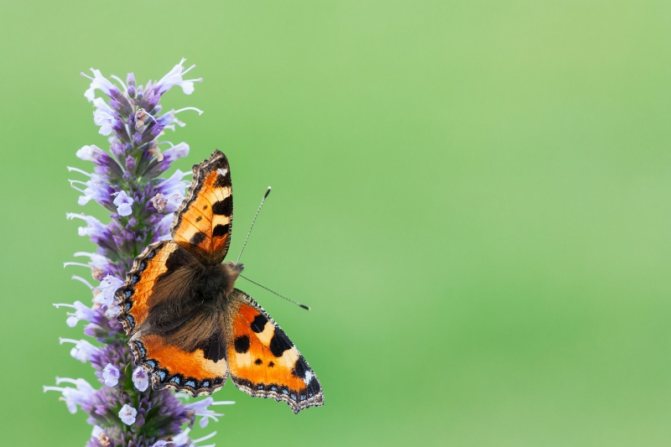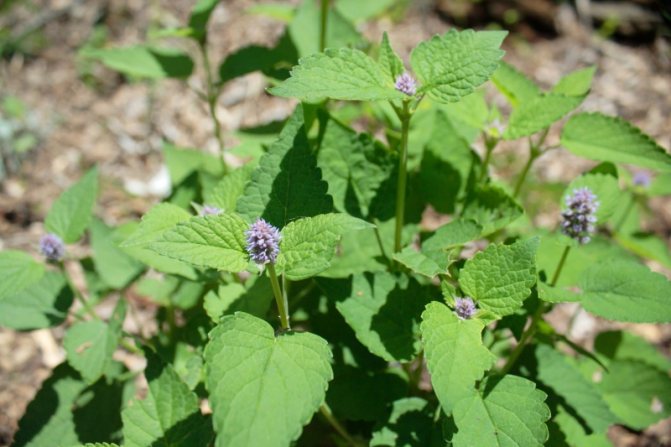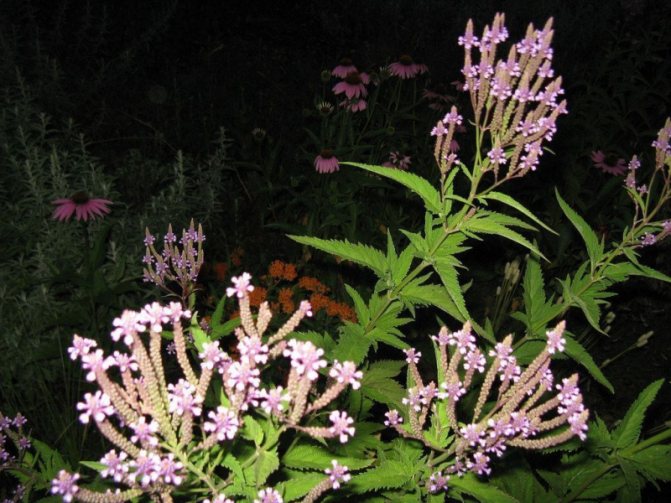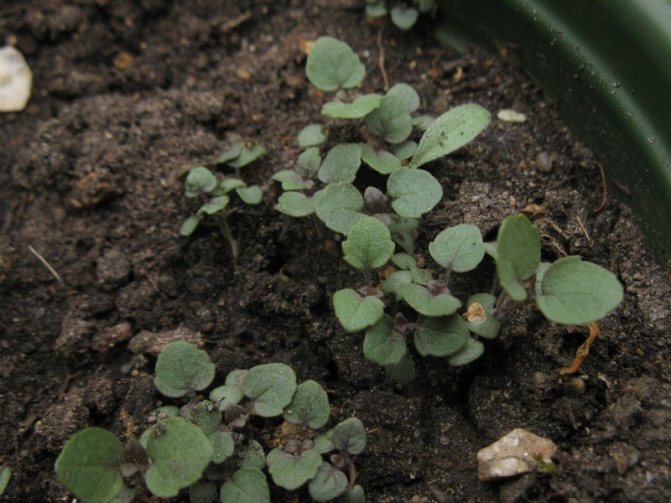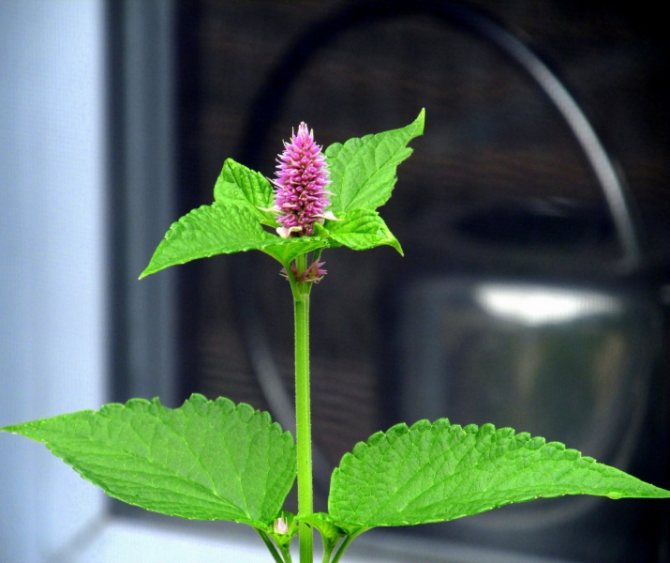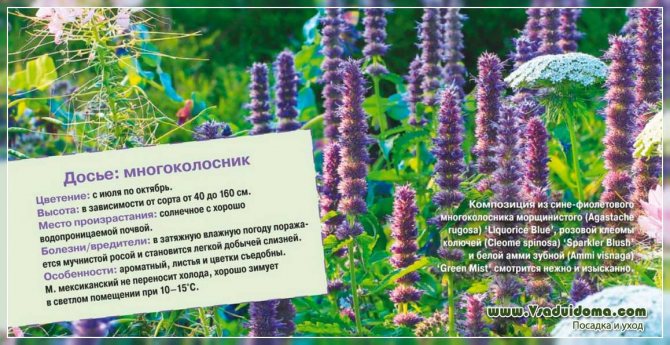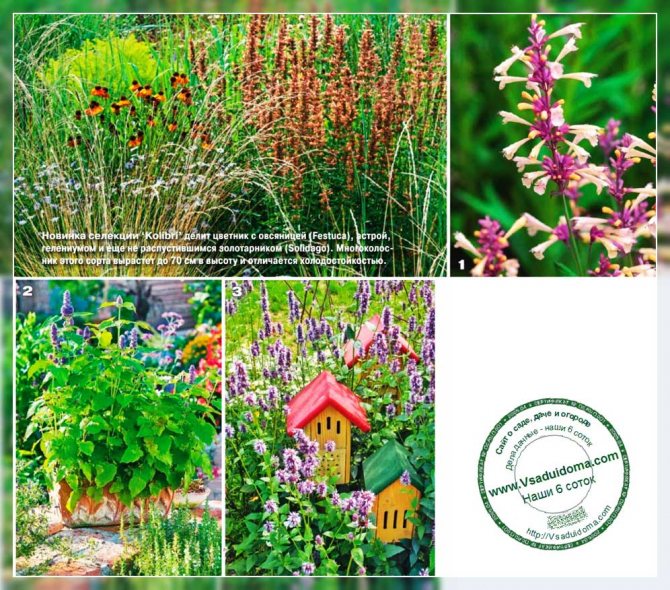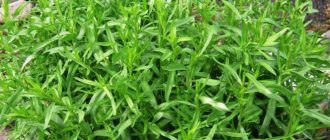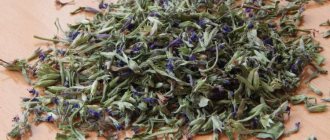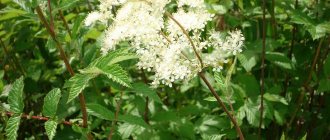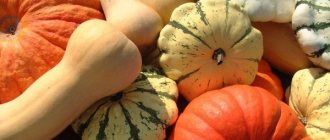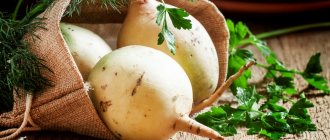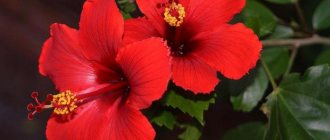Anise lofant is one of the most "multifunctional" plants on the site. The lofant is extremely decorative, its plantings exude a strong pleasant aroma, and the options for using this plant in folk medicine and cosmetology simply cannot be counted. Even a novice gardener can cope with the cultivation of aniseed lofant. The plant is absolutely unpretentious to the soil, to care. In this article we will figure out how you can use anise lofant for medicinal purposes, how to grow and harvest this plant.
Description of the plant
Lofant is a herbaceous perennial crop from the Yasot family. Depending on the place of cultivation and characteristics, the plant has many different names: aniseed hyssop, mint, fennel grate.
Anise lofant is a shrub about one and a half meters high. The leaves are shaped like nettles. The anise variety blooms with lilac, blue, white flowers, collected in spikelets. The stems and leaves of the herb contain many nutrients. Decoctions, tinctures are prepared from them, creams and other useful products are made.
Aniseed lofant varieties
Breeders are not abandoning their attempts to develop a new variety of lofant, which will have improved characteristics. If you smell the inflorescences of a lofant of different varieties, you can be surprised at the variety of aromas. Some varieties smell more like anise, while others smell more like mint or apple. You can buy seeds of various varieties of aniseed lofant at any gardening store. The following varieties of anise multifilament deserve the greatest love among gardeners:
- "Snowball";
- "Memory of Kapelev";
- "Witch Doctor";
- "Premier";
- "Dandy";
- "Summer resident";
- "Astrakhan 100";
- "Honey bee blue", etc.
Plant history
For the first time, the essential oil of aniseed lofant was mentioned by Hippocrates. The Romans and Greeks used the plant to improve appetite. It was also used in Ancient China, India, in Kievan Rus, where the plant was used as a seasoning for making soaked apples.
Lofant has been credited with many medicinal properties for a long time. The plant has been widely used in medicine and food for thousands of years. When used correctly, the multi-grate does not do any harm, but, on the contrary, only benefits.
Since ancient times, the properties of aniseed lofant have been known to the Indians. They used the plant to treat purulent wounds and other skin diseases, as well as pathologies of the respiratory system, fever, and diarrhea. In European countries, the plant was grown as a honey plant and as a decorative garden decoration.
Now the lofant is used only in folk medicine, and is also grown as an ornamental plant. It is not used in official medicine. Despite this, mint was recognized as promising for the creation of a variety of drugs with antibacterial, antioxidant, fungicidal, and immunostimulating properties. The piliotropic property made the plant indispensable in cosmetology.
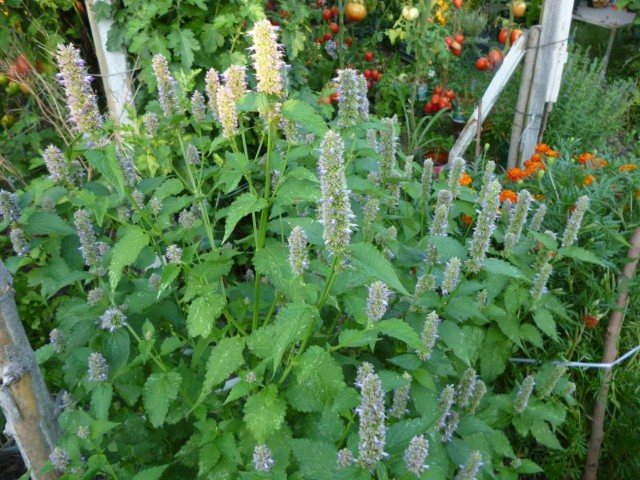
Anise lofant - care
Anise lofant is a herbaceous perennial plant that is unpretentious not only to the soil, but also to care. Let's consider the main "requirements" of a multi-grate:
- watering. You still have to water the anise lofant, like most other ornamental plants in the garden.Do this as needed, as the earthy clod around the plant dries out. It is worth noting that the anise multiforme is a plant that tolerates dry times well. But regular overflow is more dangerous for a perennial, since its root system simply begins to rot;
- weeding. To maintain the aesthetic appearance of planting aniseed lofant, you will have to regularly get rid of weeds, which can also be an additional carrier of pests and diseases;
- loosening. To ensure that the plant's root system gets enough air, periodically loosen the soil around the plant. Avoid the formation of a crust on the surface of the soil;
- top dressing. As already mentioned, anise lofant is unpretentious to the composition of the soil. But in the case of slow growth rates, poor flowering, you can feed the plant with any complex fertilizer, carry out foliar feeding;
- removal of inflorescences. Faded inflorescences of a lofant will only spoil its appearance, and therefore they should be removed in a timely manner. Gardeners who grow lofant as a medicinal plant also recommend preventing seed ripening and self-sowing of the plant. "Self-grown" plants have less pronounced healing properties.
Chemical composition
The beneficial properties of aniseed lofant are determined by its chemical composition. This plant began to be investigated only in the 21st century, which is why not all the composition is yet known. Scientists have found tannins, flavonoids, alkaloids, phenolic compounds, as well as ascorbic, caffeic, citric, malic acids in this plant. The composition includes B vitamins, useful trace elements such as iodine, iron, zinc, manganese.
The aerial part contains up to fifteen percent of the essential oil, which contains methylhavicop.
Anise lofant - landing
Choosing the time for planting aniseed lofant
Anise lofant can be planted both in spring and autumn. Choose one or another planting time depending on the planting method.
- Spring landing. You can plant anise lofant at the end of March if you have chosen a seedling growing method. If the method of planting directly into the open ground was chosen, then the period from April to March is suitable.
- Autumn planting. Some gardeners prefer to plant anise lofant at the end of October immediately in the open ground.
Please note that the anise lofant grown by the seedling method will bloom before the lofant that was sown in the open ground.
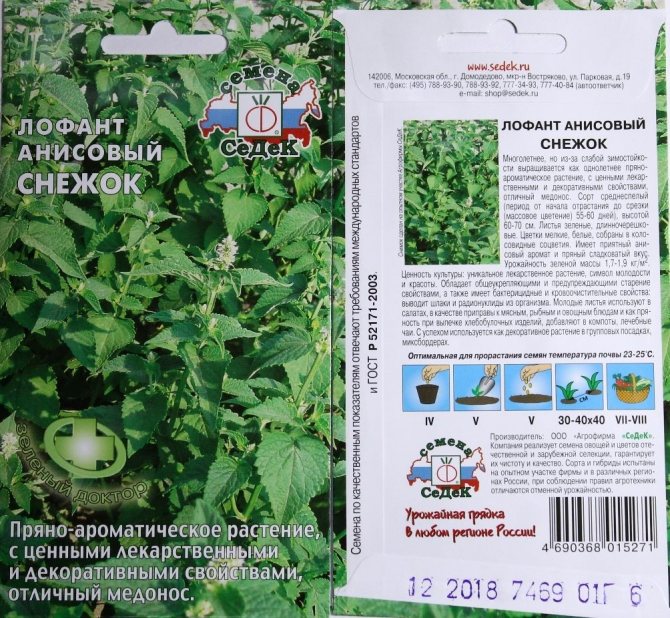

Choosing a place for planting aniseed lofant
The choice of a place for planting aniseed lofant should be taken with attention. This perennial can grow in one place for up to 6 years, if conditions are comfortable for him.
- Anise lofant is not picky about the place of growth, but it is better to choose a site that will be protected from strong winds.
- Anise lofant just needs sunlight. Choose a well-lit area or an area with diffused light. Some varieties of aniseed lofant can grow successfully in shaded areas, but very rarely. Please note that the lack of lighting during the autumn sowing of a lofant will certainly affect the quality of flowering next year. Gardeners recommend organizing additional lighting for this perennial.
- When choosing a planting site for aniseed lofant, it is worth considering the location of other ornamental crops. The plant also looks impressive in single plantings. Of course, you should avoid the immediate vicinity of the fennel grate with garden crops.
- When choosing a planting site for aniseed lofant, it is also worth considering what plants grew in this area before it. It is undesirable to plant a multi-grate in the place of already existing lofant plantings. Every 6-7 years, the place of growth should be changed in order to enable the soil to renew its reserves of nutrients.
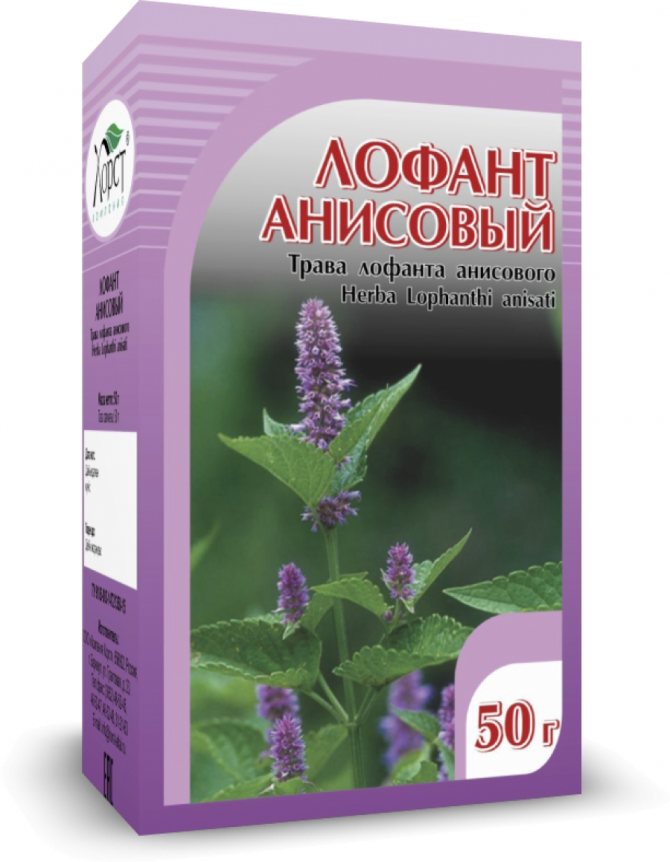

Choosing the soil for planting aniseed lofant
Even a novice gardener can cope with the cultivation of aniseed lofant, since there is no particular trouble with the choice of soil for this decorative perennial. Here are some guidelines that will allow you to grow a lush plant up to 150 cm in height:
- avoid planting a lofant in swampy ground;
- avoid planting aniseed lofant in too sandy soil;
- the optimal soil for anise lofant is sandy loam and well-drained;
- anise lofant will not grow very intensively in too acidic soil. Give preference to soil with a slightly acidic alkaline reaction or neutral.
Even in case of non-observance of these recommendations, the anise lofant will take root well and will delight you with its fragrant inflorescences, since this perennial is completely unpretentious.
We grow seedlings of aniseed lofant
Growing seedlings of aniseed lofant provides earlier flowering of perennials compared to planting in open ground. Consider a sample instruction for sowing seeds of a multicolor at home:
- first you need to purchase suitable planting material. You can buy aniseed lofant seeds in almost every gardening store. Be sure to pay attention to the expiration date of the planting material. Otherwise, waiting for the shoots of the lofant will be in vain;
- aniseed lofant seeds must undergo pre-planting preparation. To begin with, soak the seeds in a weak solution of potassium permanganate for 30 minutes to disinfect them. Then remove the seeds, place them on a piece of cheesecloth to dry. Place the lofant seeds directly in the gauze in the refrigerator for 1 day;
- for sowing seeds, you can buy ready-made nutrient soil in the store or take ordinary garden soil if it is quite nutritious in your area. Be sure to steam sterilize the soil;
- prepare a container of suitable size for sowing seeds. Lay a drainage layer at the bottom, fill the container with sterilized soil. On the surface, make grooves about 0.5 cm deep;
- sow the seeds, gently sprinkle them with water at room temperature, cover them with soil;
- in order to create the most comfortable conditions for germinating seeds, be sure to cover the container with foil or glass;
- after about 1 week, you will notice shoots of aniseed lofant. Water them between the rows, adding a little boric acid to the water;
- after the seedlings get a little stronger, the shelter can be gradually removed. After a month, the seedlings of the lofant will reach a sufficient size for their picking into separate containers;
- adult seedlings of aniseed lofant are planted in open ground at the end of May, when warm weather sets in. Maintain a minimum distance of 25 cm between individual plants and 50-60 cm between rows.


Planting aniseed lofant in open ground
Planting aniseed lofant seeds directly into open ground can be carried out both in spring and before winter. Consider a sample instruction for sowing seeds:
- if you decide to sow aniseed lofant seeds in the ground in the spring, then it is advisable to prepare a site for planting in the fall. Dig it up thoroughly, add organic matter, potassium salt, superphosphate;
- in the spring, dig up the site again, level it and build furrows into which you will sow the seeds of aniseed lofant. The approximate depth of the groove is 2-2.5 cm, and leave a distance of 50-60 cm between the rows;
- spring planting of aniseed lofant in open ground usually occurs in March;
- sow the seeds into the furrows. The soil must be moist;
- it will take longer to wait for the shoots of aniseed lofant in the open field than when growing at home. You will see seedlings in about 2-3 weeks.At first, you need to take care of a young lofant carefully. Water the plants as needed, remove the weeds, and by the fall the multicolor will bloom;
- you can plant anise lofant in open ground in the fall. In this case, the plant will begin to "wake up" in spring very early, and flowering will not take long to wait.
What are the benefits of aniseed hyssop
According to its medicinal properties, anise lofant is able to compete with powerful essential oil herbs. Hyssop oil has a broad anti-inflammatory, antifungal, antibacterial effect. The concentrated broth can be used as an external remedy for fungal skin ailments. Baths are made with it, which disinfect, soothe.
Tinctures have a stimulating effect on the digestive system, normalize metabolism. Hyssop is an active biostimulant and is used as a tonic. Regular use of the herb in food helps to boost immunity.
Means prepared from raw materials help to fight mental and physical fatigue: they fight stress, increase the efficiency and endurance of the body. Also, the plant has valuable properties that help slow down the aging process.
Correct use of aniseed lofant allows you to remove all toxins, toxins and other harmful substances from the body.
Essential oil can reduce the effects of radiation.
Hyssop tincture helps with headaches, insomnia. Also, this plant has a positive effect on male potency and helps to cure prostatitis.
The most valuable thing about aniseed lofant is the essential oil. For its preparation, use the aerial part of the plant collected during the flowering period. Raw materials are used in medicine, cooking, cosmetology.


Useful and medicinal properties of a lofant
The multi-grate has multiple positive effects on the human body. It effectively removes toxins, helps to recover from alcohol or food intoxication, improves the general condition of blood vessels, and eliminates the symptoms of hypertension.
Lofant herb actively fights infection, has antiviral and anti-inflammatory properties.
It is used to rejuvenate the skin and the body, normalize mood, increase libido and male strength, stabilize the activity of the nervous system and enhance stress resistance.


Mexican mint, as the plant is also called, has hepatoprotective properties and helps to increase the resistance of the human body.
Interesting: The benefits and harms of senna herb, use for constipation, for weight loss
The medicinal properties of raw materials are diverse.
These include:
- antioxidant;
- anti-sclerotic;
- bactericidal;
- normalizing metabolism;
- pain reliever;
- enveloping;
- preventing the development of skin diseases;
- antitussive;
- antispasmodic;
- stimulating the production of breast milk;
- tonic;
- calming;
- helping to speed up the healing of burns or wounds, etc.
When to use a lofant is not worth it
Despite the small number of contraindications, the Multicolor should not be used throughout the entire period of gestation and subsequent breastfeeding of the child.
If it must be used, then you must first consult with your doctor and carry out therapy under his strict control. It is better to suspend lactation for the period of treatment.
You should not use the Tibetan honey plant lofant with persistent hypotension in order to avoid the development of collapse.
An insufficient content of platelets in the blood plasma is also the basis for completely abandoning its use.
Patients who are prone to frequent allergic attacks cannot be treated with the Multilayer.
Healthy people need to observe the reactions of the body during therapy with medications containing the plant. If unpleasant sensations have arisen, edema has developed or dyspeptic symptoms are observed, then it is better to cancel their reception. If the noted symptoms stop, it means that the patient is contraindicated for treatment with the prescribed means.
All people undergoing drug therapy with the inclusion of such raw materials in their composition must first consult a specialist and undergo a complete examination of the body.
How to use
A variety of remedies are prepared on the basis of a lofant: extracts, tinctures, decoctions are made. They have a therapeutic and prophylactic effect on the body, and also prevent the formation of cancer cells.
Quite often, the herb is prescribed for developmental delays, for people in old age. Fresh leaves are used as a seasoning for fish and meat dishes, added to jams. The crushed seeds are added to baked goods.
In medicine, hyssop is used to treat the following ailments:
- Pneumonia, bronchitis.
- Gastritis, peptic ulcer disease.
- For digestive disorders.
- With liver pathologies.
- With increased blood pressure.
- Hyssop helps with angina pectoris.
- Treats atherosclerosis.
- Helps with headaches.
- ARVI.
- Relieves nervous tension, helps with insomnia, treats nervous tension.
- Prevents aging processes.
- Strengthens the immune system, tones up.
- Treats dermatitis, acne, burns.
- Reduces the level of radiation, helps to fight the negative effects of the environment on the body.
- Tea with a lofant is recommended for children with stunted growth.


How to prepare medicines
For lofant treatment at home, you can use the popular recipes below.
Decoction
Features. The remedy is popular for the treatment of respiratory tract: bronchitis, pneumonia, pulmonary catarrh, tuberculosis, asthma.
Preparation and application
- It is better to brew a lofant in an enamel bowl, for which 100 g of chopped grass is poured with a liter of boiling water.
- Put the mixture on low heat, boil for five minutes.
- After removing from heat, add 150 g of sugar to the product, mix well.
- After cooling, filter the broth, take half a glass once a day.
Wine tincture
Features. The product obtained as a result of infusion stimulates appetite, digestion, and treats inflammatory diseases of the gastric and intestinal mucosa. When used externally, the tincture accelerates wound healing.
Preparation and application
- 100 g of chopped dried herb plants are poured with a liter of white wine. It is advisable to use a dry variety.
- The mixture is placed in a dark, cool place for three weeks, the container with the tincture is shaken every day.
- After the specified period, the agent is filtered, taken orally by a teaspoon, three times a day, or used for compresses.
Infusion
Features. It is used internally for diseases of the digestive tract, externally used for conjunctivitis, wounds, burns, herpes rashes.
Preparation and application
- In a thermos, place 20 g of dried chopped herbs of the plant, pour a liter of boiling water.
- After insisting for 25 minutes, the product is filtered through cheesecloth.
- It is taken orally in 100 ml up to three times a day or used for washing the skin.
Syrup
Features. It is used internally to treat colds, coughs, to strengthen the body, field of past diseases.
Preparation and application
- One and a half kilograms of sugar are added to a liter of hot lofant broth.
- Put on low heat and evaporate the product until a syrup of moderate viscous consistency is obtained.
- Take with a tablespoon, up to five times a day.
The use of lofant seeds in folk medicine is not practiced. Moreover, inflorescences that already have fruits are not suitable for harvesting.


Contraindications
The lofant has anise contraindications. This plant cannot be used for thrombophlebitis, under reduced pressure. It is not recommended to take the funds obtained from the plant for those who suffer from intolerance to the components of the herb.
Lofant is contraindicated during pregnancy and lactation.
Knowing the beneficial properties and contraindications of aniseed lofant, you can decide whether the plant is suitable for taking. But in order to be completely sure that this herb will have a positive effect on the body, it is recommended to consult a specialist.
Harvesting and storage
Leaves for medicinal and culinary uses can be harvested as they mature. Flowers are removed only at the beginning of budding, since then substances harmful to the body accumulate in them. You can cut the plant with ordinary scissors or sharp pruners, avoiding lignified stems. It is recommended to cut no more than 40% of the plant at a time so that the rest can recover during the season.
Lofant greens can be stored dried or frozen. It is advisable to choose a glass or ceramic container, since they do not impair the richness of the taste. The maximum storage period for dry leaves is 18 months from the date of collection.
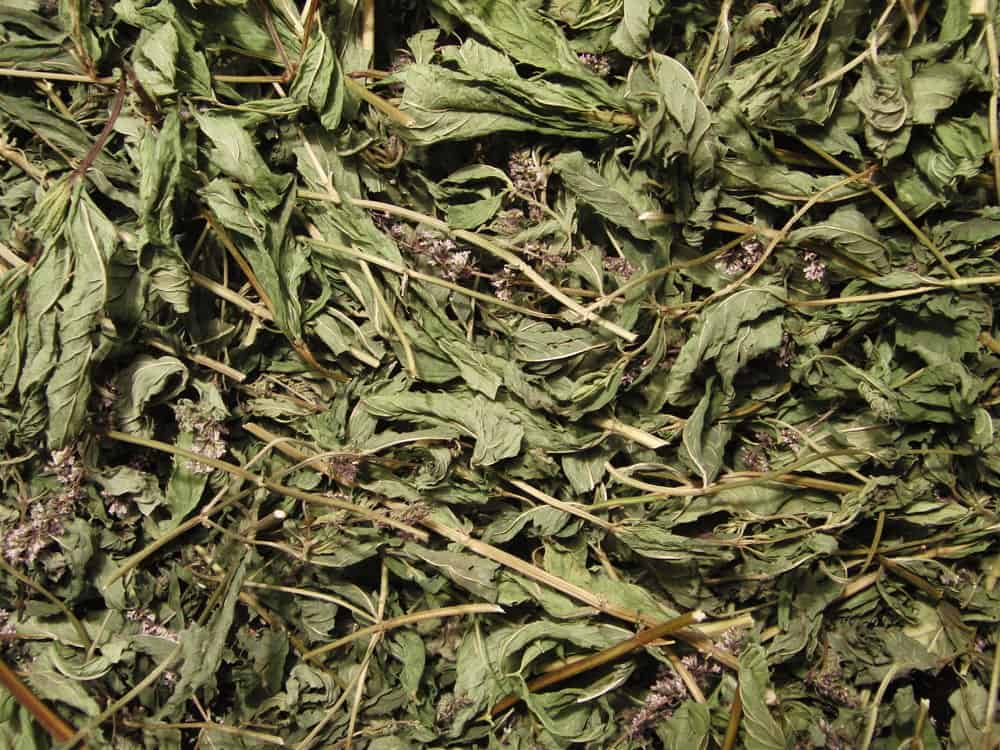

Healing infusion
With pathologies of the pancreas, with urolithiasis and cholelithiasis, with VSD, diseases of the pancreas, liver, an infusion is prepared from a lofant. For him you will need a spoonful of raw materials, which is poured with a glass of boiling water, the product is infused for two hours. Then the composition is filtered and taken one hundred grams three times a day. You can add a teaspoon of honey to the infusion. Treatment of pathology lasts a month, then a two-week break is taken.
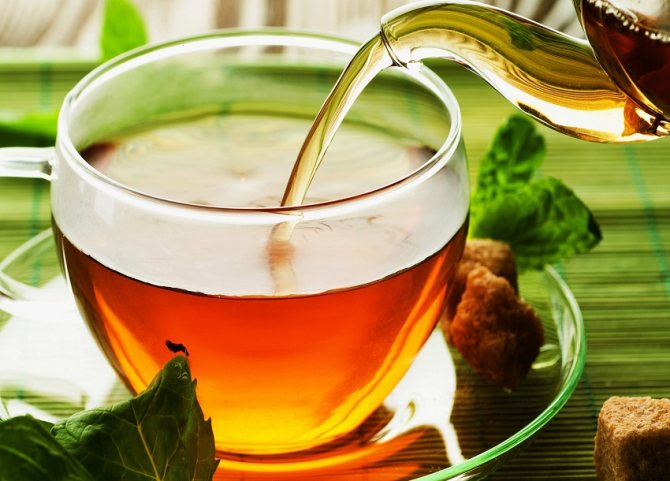

Herbal mixture
With strong nervous excitement, menopause, arrhythmia, the following collection helps: the leaves and flowers of the lofant are mixed in equal parts with lemon balm and lemon mint. Then a spoonful of the mixture is taken and steamed with a glass of boiling water. The remedy is infused for a couple of hours, fifty grams is taken twice a day before meals. Duration of admission is a month. Then a week break is taken and the treatment is repeated.
With persistent hypertension, dizziness, tinnitus, atherosclerosis, the following collection is shown: one part of mistletoe and two parts of hawthorn, yarrow, lofant are mixed. Then a tablespoon of the mixture is taken and poured into a glass of boiling water. The tool is infused for three hours, filtered and taken in a third of a glass three times a day before meals. Duration of admission is a month. After a week break is made, and the course is repeated twice more.
External use
For external use, ointments and decoctions are prepared from the lofant. They help to cope with skin ailments. Anise hyssop enhances tissue regeneration, has a tonic effect. This plant has unique properties that are widely used in cosmetology. On the basis of the plant, shampoos are made that promote active hair growth.
Decoctions are added to baths, which help to normalize sleep, promote healing of purulent wounds, and treat acne. The broth is rubbed onto the face to eliminate wrinkles and give the skin a radiant appearance.
Fresh leaves can be applied to wounds. The zinc included in the composition will disinfect the site of injury, and tannins will reduce pain.
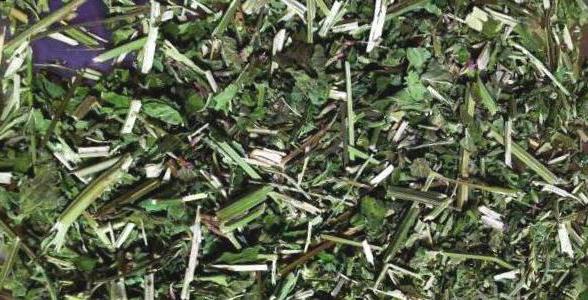

Unique plant
Anise lofant, the photo of which is presented in this article, has unique healing properties. It can be used by both adults and children. The plant is of particular value among young parents: bathing children with the addition of a decoction helps to normalize sleep, soothes, relieves stress.
The rich vitamin and mineral composition brings a lot of benefits.It helps to get rid of almost all pathologies associated with low immune defense. Raw materials are collected in dry weather after the dew has melted. Dry the plant in a well-ventilated area or under a canopy. For storage, use cloth bags or glass containers. Raw materials are stored for a year.
Reproduction
Lofant can be propagated both vegetatively and generatively. The most common breeding methods are:
- Division of the bush. In early autumn or early spring, before the appearance of new shoots, an adult shrub is divided into 3-5 parts so that each has a well-developed root system. Delenki are immediately determined to a new place, after placing a drainage in the hole, and watered abundantly after planting.
- Cuttings. Shoots are rooted similarly to any garden shrubs in a nutritious substrate, providing increased humidity, that is, placing them in a greenhouse or greenhouse.
- Seed method. Growing a lofant from seeds is one of the popular breeding methods. Seeds are sown directly into the ground in early May, after the last frost. To do this, make grooves about 2 cm deep, where the prepared planting material is placed. For better germination, seeds can be soaked in a growth stimulant solution. As young plants germinate, plantings are thinned out, leaving stronger and more viable ones.
- Seedling method. Lofant seeds are sown in large containers in early April. After the appearance of 2 pairs of true leaves, the plants dive into separate pots. In the spring, after the last frost, the seedlings are assigned to a permanent place. With this method of reproduction, the flowering of the polygranular occurs in the very first season.
Advice! For more even sowing, small lofant seeds are mixed with clean fine sand.

